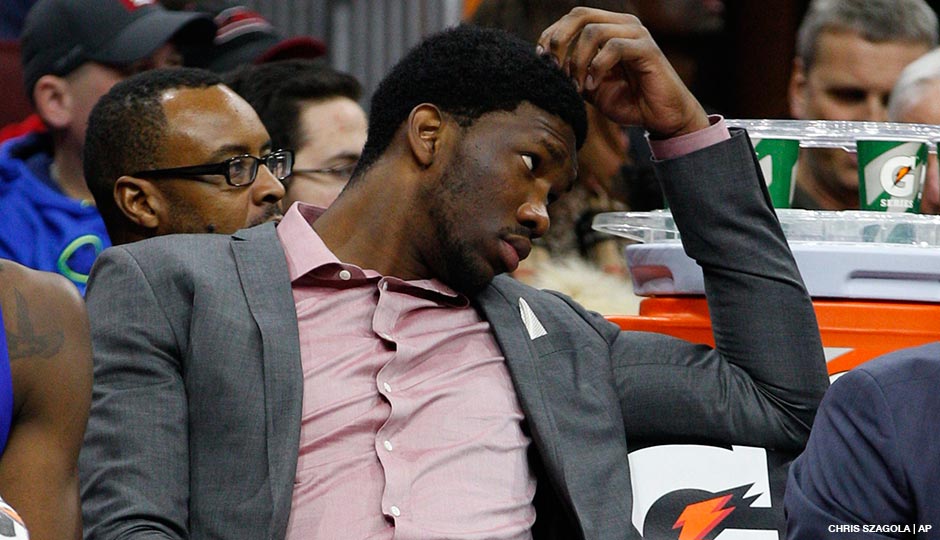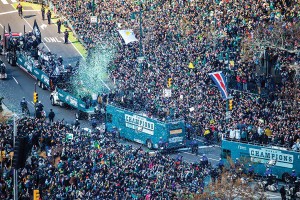Surgeon on Sixer Joel Embiid’s Foot: “Bone’s Integrity Better Than Expected”

Joel Embiid looks on from the sidelines during the January 7, 2015 game between the Milwaukee Bucks and the Philadelphia 76ers at the Wells Fargo Center.
On July 11th the Sixers announced that Joel Embiid would require a second surgery to repair the navicular bone in his right foot, an injury that was first discovered mere days before the 2014 draft, and one which caused Embiid to miss his entire rookie season.
The surgery, which included replacing the two existing screws in Embiid’s foot along with a bone grafting procedure intended to help strengthen the area and promote healing, was performed Tuesday at the Hospital for Special Surgery in New York City.
“Visual inspection suggested good vascularity of the bone,” said Dr. Martin J. O’Malley, the surgeon who headed up the operation. “We were able to identify that bone’s integrity was even better than expected and has been put in a great position to support full recovery.”
O’Malley is a renowned foot and ankle specialist who has performed several surgeries on high-profile NBA players. His recent clients include Nets’ center Brook Lopez, who had surgery in January 2014 to repair a fractured fifth metatarsal in his right foot, and Kevin Durant, who underwent a bone graft for the fifth metatarsal in his right foot this past April.
O’Malley, who performed the majority of the operation, was joined by Dr. Duretti Fufa, a colleague of O’Malley’s at the Hospital for Special Surgery, Dr. Richard Ferkel, from the Southern California Orthopedic Institute and the surgeon who performed Embiid’s initial surgery last season, and Dr. Jonathan Glashow and Dr. Christopher Dodson, the Sixers’ chief medical officer and head physician, respectively.
“Any one of [the surgeons] could have performed this surgery, at some level,” Sixers general manager Sam Hinkie said today when talking to reporters. “But you don’t want someone that can just perform it. You want someone who the patient feels great about, who has performed it in similar situations, and who has the most experience.”
When the team sent out its press release on July 11th announcing the need for surgery, they anticipated the operation would occur within the next 7-10 days. The wait instead dragged on for over a month without an update, causing some to wonder whether Embiid was in agreement.
According to Hinkie, when the Sixers sent out the press release on July 11th Embiid had agreed to surgery, and they had his backing to send out the press release.
The delay, instead, came down to selecting who would perform the surgery.
“From that point Joel had some additional diligence that he wanted to do, like talk to players,” Hinkie said about the delay. “He had talked to a number of the players that had first hand experience, as a patient, with the various surgeons that we were looking at. I thought it was a really reasonable approach and a good way to think about it if you’re a patient.”
Outside of the Sixers and Embiid finalizing a surgeon, the last part of the delay was getting the surgeons in the same place at the same time.
That delay, according to Hinkie, didn’t add any additional risk to the injury.
“I think my estimate stunk there,” Hinkie admitted. “But at the same time, as we kept doing more and more research, I didn’t particularly care, honestly. It’s not about me. It’s about getting the answer right, and it’s about getting everybody comfortable with where we’re headed because of the gravity of the decision.
“We grew comfortable during that period that there weren’t any particular risks to waiting. I think time is on our side here,” Hinkie said.
Hinkie reiterated that Embiid did not suffer another fracture. Instead, a CT scan in early June revealed less healing than expected.
Hinkie also addressed why a bone graft was not done during the initial surgery last year. While he was quick to point out that the Sixers weren’t involved with the first surgery, he stuck up for the decision.
“It’s not something people always start with,” Hinkie said about the bone graft. “[It’s] increasingly popular, but you’re often seeing it happen on the second time through.”
Recovery timeline
The timeline for Embiid’s rehabilitation is similar to the timeline given last year, which is in the 5 to 8 month range, according to Hinkie. That being said, don’t expect to see Embiid on the court this year.
“Call it 5 to 8 months. [But] we think of it, with a conservative approach, that it will mean the season,” Hinkie explained. “I didn’t see scenarios at that point, and I don’t see scenarios now, where you’re taking back information as he’s recovering and marking down these benchmarks against his recovery protocol, and then you’d say ‘Oh yeah, let’s throw him in a game the last 2 or 3 games of the season.’ It just doesn’t seem very likely.”
Differences this time around
The Sixers are hoping that this bone graft — which should help strengthen the area — the lessons they learned from his rehabilitation last year, new staff additions, and the fact that they will be working with Embiid from day 1 this time around will solve this problem once and for all.
“I’m optimistic. Our doctors are too,” Hinkie said. “If we all do our parts, and we all do everything we can do, every day, [I’m optimistic] that this will end in a way in which Joel can achieve all of his dreams. Nobody has talked me off of that yet.
“Do you have reason to be concerned? Of course. But nobody has told me that is still not in the cards.”
The 76ers hired David Martin from the Austrailian Institute of Sport to be the team’s director of performance research and development in late June, barely two weeks before news of Embiid’s setback initially broke. Martin, along with Todd Wright, who was hired in July as an assistant coach, as well as the head of strength and conditioning, provides the team with some fresh perspective on the situation.
“We’d be silly not to take a fresh approach again,” Hinkie said. “We have to be smarter having had a year of working with Joel under our belt, as is he.
“Our best efforts now, by definition, ought to be better than our best efforts were a year ago,” Hinkie concluded.
Hinkie was quick to remind reporters that they were not involved in Embiid’s operation last year, which occurred less than a week before the 2014 NBA draft.
“He’s under our care now. When he had this last year in June he wasn’t under our care. He came to Philadelphia with a cast on,” Hinkie said. “We will be able to manage it [from the ground up] now and take some slightly different approaches, which I think we’re prepared to do.”
Follow @derekbodnernba on Twitter.


